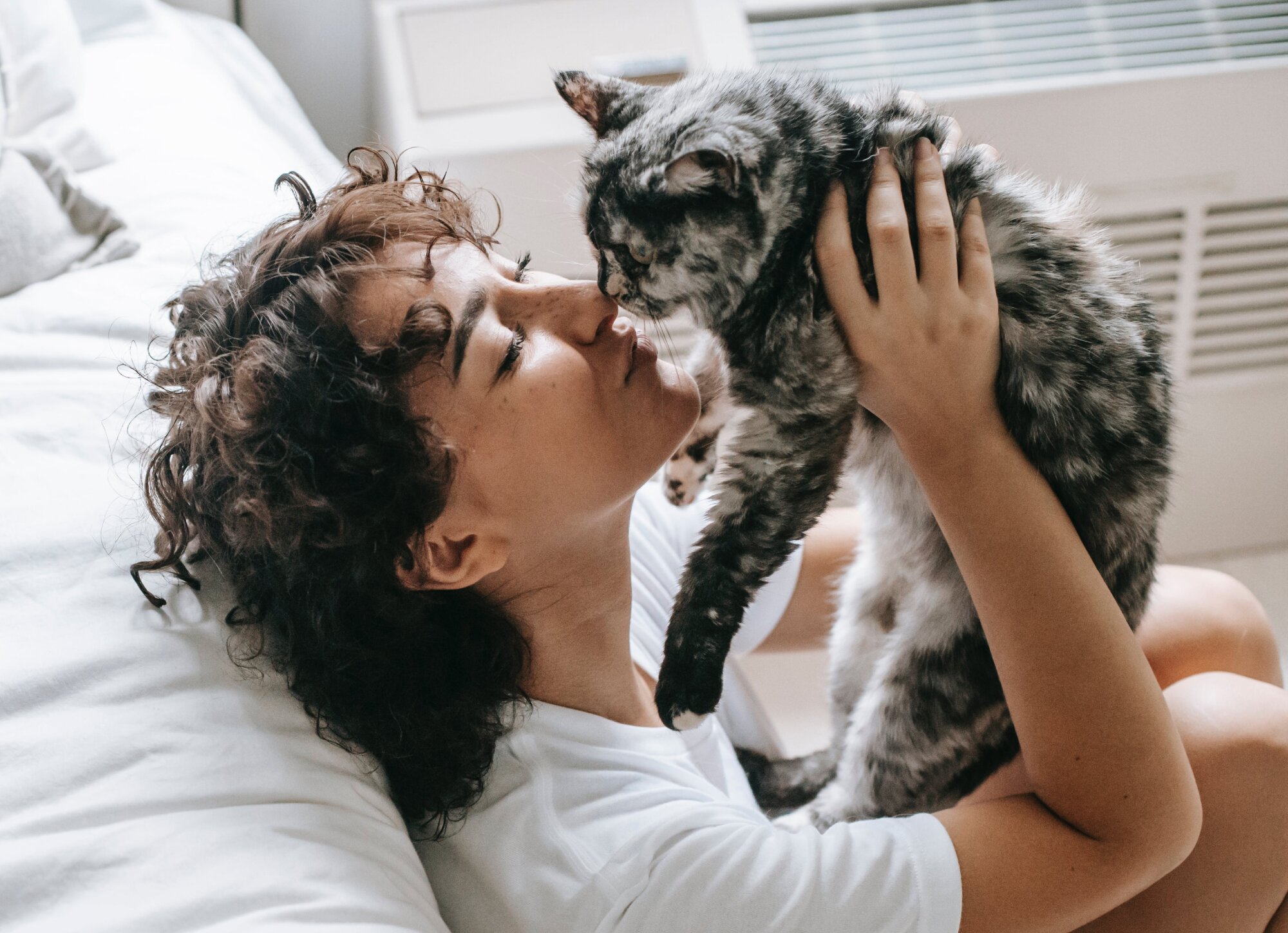From trick training to snuggling on the couch, it's fulfilling to spend time with your cat. But what happens if your new cat is standoffish when it comes to bonding?
Learning how to bond with your cat is an important skill as a pet parent. In this article, we'll cover the importance of bonding. Plus, 8 tips to bond with your kitty.
The importance of bonding with your cat
Spending time and bonding with your cat has psychological benefits for you and your pet. There are three main reasons why bonding with your cat is important.
1. It builds trust.
Spending time with your cat helps them learn to trust you with their safety and health. Showing you care and want to keep them healthy builds trust and helps your cat feel safe.
When you bond with your cat, your cat better understands boundaries and what is allowed. This makes leaving them home alone stress-free. It can take time to build trust with your cat, so stay patient and keep trying.
2. It reduces anxiety.
Spending time in your cat's presence actually reduces stress and anxiety. Petting and playing with your cat releases endorphins and happy chemicals in your (and your cat's) brain.
3. It promotes companionship.
Companionship is important to cats and humans alike. Having a kitty that relies on you, trusts you, and spends time with you can boost your mood and overall mental health.
Like dogs, cats can be affectionate, social animals. Bonding with your cat helps you understand their personality and makes your cat feel comfortable.
8 tips to bond with your cat
Bonding is an important part of cat ownership. Learn to bond with your cat successfully with these 8 tips.
1. Understand welcoming cat behaviors.

Cats primarily communicate with their tails. But, there are other signs and behaviors most cats show to communicate when they are ready to interact.
Some common welcoming cat behaviors include:
- Upright tail
- Head bumping
- Head rubbing
- Slow blinking
If your cat is walking around with their tail upright, it means they are happy and willing to interact. A twitching tail tip can mean your cat is especially excited or happy.
Head bumping and rubbing is an intimate behavior reserved for your cat's trusted humans and closest pet friends. Cats release facial pheromones through their scent glands when they rub their heads on things. These pheromones let your cat know that they are in a safe environment.
A slow blink can be a sign of affection and happiness in cats. If you catch your cat staring at you and blinking slowly, try slowly blinking back. This can be a way to bond with your cat without touching them.
2. Look out for signs of anxiety and stress.

Every cat breed and personality is different. It may take some trial and error to find out how your cat likes to bond and what makes them uncomfortable.
Give your cat some space if they:
- Have flattened ears
- Have dilated pupils
- Have hair standing upright
- Are hiding
- Are purring
- Are growling
- Are hissing
BONDING TIP: Understand your cat's body language
Yes, even purring can be a sign that your cat is feeling overwhelmed. Purring is a self-soothing mechanism cats use to calm themselves down.
Growling and hissing are more signs that your cat may feel stressed or overwhelmed. If you observe any of these signs while trying to bond with your cat, take a break.
3. Add enrichment activities to their daily routine.

Many cats love simple enrichment activities. Cat enrichment can help kittens and adult cats get comfortable in a new environment, feel confident in a social group, and bond with their owners.
Enrichment comes in many forms, including:
- Cognitive enrichment
- Physical enrichment
- Food enrichment
- Sensory enrichment
- Visual enrichment
- Environmental enrichment
- Social enrichment
Whether you are introducing your cat to a new environment, trick training, trying new food, or socializing them with friends, enrichment can make transitions easier.
BONDING TIP: Build a cat fort
Try adding a cardboard box to your cat's environment and see how they react. If your cat likes the box, try incorporating specific enrichment activities that involve the box, like building a cat fort.
To build a cat fort, all you need are cardboard boxes and blankets. Stack boxes and blankets on top of each other to build a cozy fort for your pet. To add some extra fun, use a laser pointer and treats to guide your cat through the fort.
4. Give your cat some space.

Establishing a strong bond with your cat takes time. Don't rush it! Cats need plenty of space before they initiate contact.
Some cats are naturally social and ready to spend time with their humans instantly. Other cats may take several days or weeks to interact and start bonding with their owner.
It's tempting to pick up your new cat and snuggle them constantly. But, it's better to wait and let your cat come to you when they're ready for attention.
BONDING TIP: Create a cat corner
A fun way to give your cat the space they need is by creating a cat corner. Be sure your cat's corner is in a low-traffic, quiet area of your home.
Place their litter box, cat bed, and some of their favorite toys with catnip in their corner. Their cat corner can be an oasis when they need personal space or feel stressed.
5. Talk to your cat.

It may sound silly, but talking to your cat during meals and play time can promote bonding. Talking during these times may help your cat associate the sound of your voice with positive experiences.
6. Socialize your feline friend with other cats and humans.

Some social interaction is healthy for cats. And, it's better to socialize your kitten right away rather than wait until adulthood.
BONDING TIP: Start slow when socializing your cat.
To socialize your cat, start slow. Encourage your friends and family to avoid approaching your cat to allow your cat to get comfortable in their presence.
But, do not force interaction if your kitty is showing signs of agitation. Pay close attention to your cat's tail, ears, and head for a sign of stress while socializing.
When your cat is ready, they will initiate a bond with the other pet or human on their own terms. If your kitty becomes overwhelmed, remove them from the environment. Practicing socializing in your own home can be beneficial, especially if your kitten has a safe space to retreat to.
7. Prioritize their overall health.

Some cat health problems may limit your cat's ability to exercise, play, and move. Depending on your cat's condition, cater your plan accordingly.
BONDING TIP: Visit a doctor of veterinary medicine regularly.
When you take your new cat to the vet for a cat check-up, take note of any conditions or illnesses they have. Veterinary medicine is key to keeping your cat's health top-of-mind.
If your cat has arthritis or another condition that makes getting around difficult, try introducing grooming and snuggling bonding activities.
If your cat struggles with cat fleas or dog fleas, use applying their flea and tick treatment as a bonding activity. Spending time caring for your cat’s condition can strengthen your bond.
8. Stay positive and persistent.

It may take time to learn what incentives and activities your kitty likes. Tips that work for one cat may not work for yours.
BONDING TIP: Be patient when bonding with your cat. Cats need time to get comfortable.
Cats see the world differently than humans. Remember to consider their personality and health. The long-term benefits of bonding with your cat are worth the persistence and patience it requires.
Try different methods to build your relationship and be patient. If your cat seems standoffish at first, don't fret. Keep trying on a daily basis and watch your relationship slowly grow and change.


